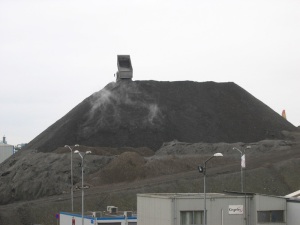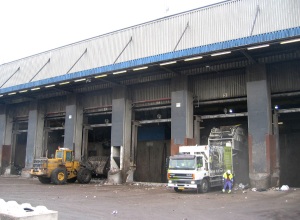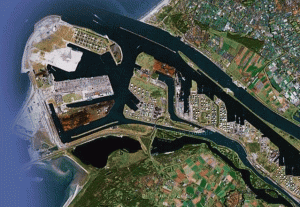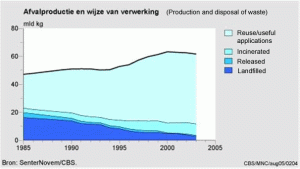April 8, 2009 — AVR Rijnmond, Rozenburg, the Netherlands

Snail Mountain
A road spirals up the mountain, around back and to the top, where the big trucks back up to the very edge to release a load of ash, making a lovely dust cloud as the stuff rolls down the hill. It seems a little precarious to me. Here’s another job I’m glad I do not have.
In Dutch, bottom ash is referred to as “slakken,” which I suspect is just a close relative of “slag,” the waste material produced in coal mining. But “slakken” also means “snails” in everyday Dutch, which makes for a very lively image.
The mountain, currently growing on the grounds of the AVR Rijnmond, is a little higher than usual, I’m informed, because of the economy. Less trash comes into the front door, it’s true, but the snails don’t get carried out the rear as they usually are either. Demand for bottom ash—which is used in roads, dikes and other infrastructure that requires massive amounts of more or less inert matter—is down even further than the supply of trash.

Gifts Delivered
Despite the troublesome shortage of garbage of the moment, there’s plenty of activity at the front door. My guide refers to it as the “bordes.” It reminds me of the “bordes” that the Dutch queen stands on at Soestdijk Palace, on her birthday, to receive her loyal subjects bringing birthday presents. I doubt, however, that anything as useful as ash and energy results from that annual patriotic operation.
Unlike the loyal subjects, the trucks back up to the doors and spit out their treasures without ceremony. A cloud of dust and exhaust blows back out into the open. A thick smell of rot hangs in the air. Gigantic grabbers hanging off the ceiling inside pick up the waste and deposit it on the dissassembly line. Then it trundles into the tops of the seven ovens that perform the first step in its transmigration from useless trash to useful infrastructural filler. Another stream, almost as voluminous, comes in at the Laurenshaven docks in back, barges delivering containers of garbage from cities like Utrecht and the Hague.
The trash literally disappears into the maw of the incinerator, never to be seen again. It passes through the bowels of this gigantic beast like grass through the multiple stomachs of a cow. The process is entirely self-contained. A little peephole at the bottom shows a line of disintegrating trash bags on a long down escalator engulfed in flames. But there’s not a whiff of garbage anywhere, not the slightest inkling of heat. Only the little peephole confirms the conflagration within.
The plop, carried off on a conveyor to a steaming pile of slag outside, still contains some undigested matter–bits of broken glass, odds and ends of metal. The metals are removed for re-use, and what’s left is heaped onto the mountain top. Meanwhile, heat is transformed into electricity. Various kinds of nastiness are scrubbed out of the flue gas and eventually buried in landfill.

Maasvlakte (Garbage at Left)
My own historical trash has made this digestive trip as well, including a small portion in 1972 and then again a bigger batch from 1978 to 1983. Especially that earlier contribution may have helped to “fill” some of the construction at the mouth of the Maas. It’s not a very exact way of pinpointing the ultimate resting place of my garbage, but it’s as close as I’m going to get.
The whole question of whether the transmigration of trash to ash might be good or bad for the environment is obviated by the neighbors. AVR Rijnmond stands in the middle of miles and miles of chemical and petrochemical industry, which is responsible for a significant stream of hazardous waste (some of which arrives at the AVR for cleanup) as well as fugitive emissions. The whole question takes on a distinct air of futility in this environment. Nonetheless, some activists worry about ultra-small particles and traces of toxic substances sneaking out the chimney. I’m not in a position to judge if such worries have merit. I wouldn’t be surprised if there is room for improvement.
But what makes incineration unbeatable in my mind is that it makes plastic go away at the end of its useful life, yielding up a little burst of energy, a puff of usable ash, and a smidge—but just a smidge—of something impossible to reuse. It’s like absolution. Like getting a hall pass.



